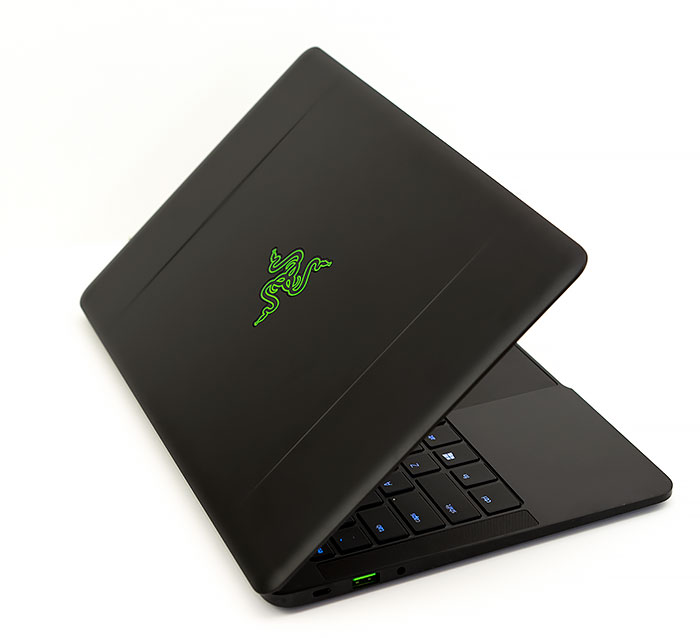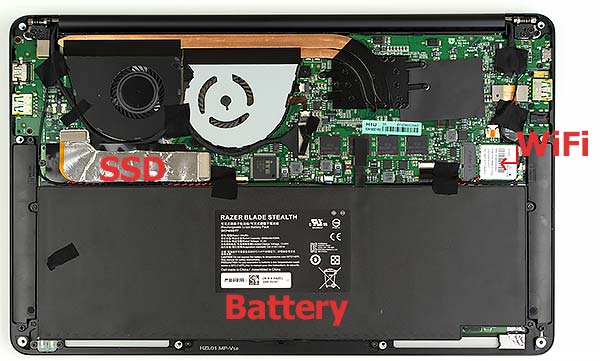|
When a gaming hardware company makes a non-gaming Ultrabook, things get a little confusing. Unlike Razer's bigger Blades with quad core CPUs and fairly strong dedicated graphics, the little 12.5" Razer Blade Stealth is an Ultrabook in matte black and Razer green clothing. It's extremely slim (Razers are always razor blade thin), very light and it has a Chroma keyboard that does lightshows befitting a 4th of July celebration. Someday, it will be something of a gamer when Razer releases the Core, a Thunderbolt 3 external graphics amplifier that houses a single desktop graphics card (you supply the card, say a NVIDIA GTX 970). The laptop weighs just 2.75 lbs. pitting it against the 2.6 to 2.8 lb. Dell XPS 13. To be fair, the 12.5" Razer is smaller than the XPS 13 and the horde of 13.3" Ultrabooks it competes against, so should be a little bit lighter. Among the lightest 12.5" Ultrabooks, the Samsung ATIV Book 9 and the 12" Apple MacBook, both of which weigh 2 lbs. it's a little heavy. But unlike those two machines, the Stealth has a Core i7 and internal fan vs. a lesser Core M sans fan.
Razer's laptops have been pricey pieces where you paid extra for the understated, high quality design and exciting specs for a slim and portable gamer. You could easily get the same specs for less by buying an MSI Stealth Pro or GS40 Phantom, a Dell XPS 15 or a full size gaming laptop. The Blade Stealth is instead almost a bargain; with a Core i7, 8 gigs of RAM and a PCIe SSD standard, it's less expensive than a similarly equipped Dell XPS 13 and challenges Asus' traditionally low prices for a classy chassis. The Razer Blade Stealth starts at $999 for a Skylake dual Core i7, 8 gigs of RAM and a 128 gig SSD plus QHD gloss touch screen. The $1,199 model we look at upgrades the machine to a 256 gig SSD. For $1,399 you can move up to the 256 gig SSD and a 4K display. The top model has a 512 gig SSD and a 4K display. All models top out at 8 gigs of RAM and have Intel HD 520 integrated graphics, two USB 3.0 ports, a USB-C 3.1/Thunderbolt 3 port, HDMI and a 3.5mm combo audio jack. The laptop has Killer 1325 dual band WiFi 802.11ac and Bluetooth--it's hard to beat Killer for throughput and reception, so we're thrilled to have it here.

Design and Ergonomics
The diminutive Blade Stealth is just a little bit bigger than the Dell XPS 13.... It's not that the Stealth is big, it's not. Rather the XPS 13 is crazy small for a 13.3" notebook. The Stealth has a matte black aluminum chassis, similar to the bigger Blade models. It's really chic and modern looking, but it attracts fingerprint oils like mad and it doesn't clean up easily. A microfiber cloth is no match; you'll need a damp cloth with a mild soap like Soft Soap. The Razer green snake logo adorns the back, and you can control its backlight level (it will always glow a bit thanks to the display panel backlighting).
The laptop is rigid and strong and the keyboard deck has no unwanted bounce. The bottom is affixed with Torx T5 screws, and there are no obnoxious plastic clips to hang up the bottom's removal. That's a sign of a well-machined chassis and bottom panel--they don't need tenacious clips to hold together tightly (there are two locator clips at the rear to align the bottom panel). The display bezel is thoroughly average, which is to say not petite. For the price, we can't complain, but it does lack the wow factor of the XPS 13 Infinity's nearly bezel-free design. Of course it does allow for a webcam up top as per normal, vs. Dell's chin cam at the bottom of the display. And that webcam is a little bit better than average at 2MP. It offers relatively detailed video, but colors are dull, which is typical of many webcams.

Ultrabooks with integrated graphics always have a single fan for the CPU, unless you're talking about the Stealth. It has two fans, and as a result our QHD review unit was relatively cool and we rarely heard the fans ramp up. They will ramp up to max speed if you're playing Bioshock Infinite for 30 minutes, but their volume isn't that loud (it's super quiet compared to the 14" MSI GS40 Phantom with dedicated graphics). The bottom never got burning hot or even uncomfortably warm, which is a nice change from Razer's bigger laptops that are both noisy and hot.
The top-firing stereo speakers with Dolby audio software are exceptionally loud for a small Ultrabook (heck, it's louder than some 15" laptops), and sound is more full than average for a machine this size.
Keyboard and Trackpad
I won't be coy--the keyboard is trying if you type at length and often. The scant 1mm of travel falls well below the 1.5mm average, and it makes the XPS 13's 1.3mm travel seem pleasant and the even longer travel of the 12.5" Lenovo ThinkPad Yoga 260 bountiful. Key actuation force is a little bit below average as well, though that didn't bother me as much--perhaps it makes sense when travel is so low. This is the price we pay for a 0.5" thin Ultrabook. Though the 12" Apple MacBook keyboard feels absolutely strange and has little key travel, I typed more accurately on it. That said, I did adjust to the Razer Blade Stealth's keyboard and typed competently after an hour, albeit with more mistakes than usual. If typing is a big part of your day, it's hard to fawn over the Stealth.
The Chroma RGB backlighting is totally cool and over the top when it comes to effects and customizations. You can choose customizations for game types like first person shooters and RTS, game specific customizations and a variety of canned special effects like ripples when you hit the keys, rotating color changes, the wave that changes colors so fast it might induce seizures in susceptible individuals, or a static color (or off altogether). It's entertaining, and a nice gaming oriented touch, even if the laptop itself isn't much of a gamer. One complaint: secondary key maskings don't light up, making it hard to find @, $ and multimedia control keys in the dark.
The Synaptics trackpad is very fast and slick, though the default cursor speed is set to slow (easily remedied via settings). It's a good trackpad with Synaptics usual group of versatile customizations for multi-touch and gestures, though we found it less accurate and Mac-like than Microsoft's bare bones but excellent Precision trackpad drivers in recent Dell XPS and Surface Book models.
Display
Razer offers the Blade Stealth with your choice of a QHD 2560 x 1440 display or a 4K 3840 x 2160 display. Both are glossy, IGZO touch screens with ample glare. Colors on our QHD review unit are vivid and saturated-- a little over saturated, which is great for content consumers but a wee bit problematic for content creators who need accurate sRGB color. Razer claims 70% Adobe RGB and full sRGB coverage for the QHD panel, and our unit beat that with 77% of Adobe RGB. The 4K model represents 100% of Adobe RGB, which is a significantly wider color gamut than the much more common sRGB standard. How does it look? Better than life in terms of saturation, and contrast looks very good. Movies and photos jump off the panel--they're very vivid and sharp. In fact, if you're a pro photographer, you'll find that photos look better on the QHD Stealth display than they do on other folks' display or when printed. If you're accustomed to 13.3" or larger laptop displays, the Razer's will seem a bit small, as do the Microsoft Surface Pro 4 and 12" MacBook. You're the best judge of whether you're OK going with a display this small.
Our QHD display measured 288 nits of brightness with good 0.36 black levels at max brightness and a contrast ratio of 790:1. The 7800K white point is too high (6500 to 6600 is ideal), but we found the display more amenable to calibration than the QHD Dell XPS 13 that stayed too cool and blue even with calibration. Razer has done a very good job with the IGZO displays, and they're the best we've seen so far on a laptop.
Performance and Razer Core
This section will be short since Razer offers one machine with your choice of a 128, 256 or 512 gig SSD (and QHD or 4K display). All models currently run on the 2.5 GHz Core i7-6500U 15 watt Intel Skylake 6th generation dual core CPU. That's the same CPU offered in many Ultrabooks, and it has half the cores and half the performance of a quad core gaming / workstation laptop like Razer's own Blade 14" and Blade Pro 17". Those of you who've owned an Alienware 13 that combines the same CPU class with dedicated graphics know that performance does take a hit, and you'll see lower fps in games compared to a quad core laptop with the same graphics card.

Of course, the Stealth has no dedicated graphics option (it's simply too small and thin to fit dedicated graphics and associated cooling hardware). You'll have to wait for the Razer Core, a not wildly portable black box with a slot for a modern desktop graphics card, plus power supply. There's no price or release date as of early March 2016. Alienware external graphics amplifiers sell for $200- $300, so we'll use that as a best guess for pricing. Keep in mind, you still have to supply the graphics card, and a desktop NVIDIA GeForce GTX 970 typically sells for $330. I wouldn't go for the even more expensive GTX 980 since the CPU will likely bottleneck the GPU in AAA titles. The Stealth + Razer Core + nice desktop graphics card won't be a cheap proposition, but it does give you the versatility of a highly portable Ultrabook plus a home gaming system with moderate gaming capabilities. The nice thing about the Razer Core is that it should work with any laptop that has a Thunderbolt 3 port (assuming full BIOS support for all functions possible with Thunderbolt 3). If you sell the Stealth, the Core could have new life with your next laptop.
8 gigs of DDR3 dual channel RAM is standard, and is in fact the only option. RAM is soldered to the motherboard and isn't upgradable. The M.2 PCIe NVMe SSD is upgradable, but the factory drive's speeds were good enough to make us happy. It's not as fast as the top dog Samsung 950 Pro, but unless you spend significant time copying copious numbers of files to and from the drive daily, that won't matter.
|
|

